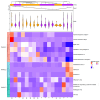Viral Fragments in the Urine Proteome: New Clues to the Cause of Fever
- PMID: 40282183
- PMCID: PMC12024789
- DOI: 10.3390/biology14040318
Viral Fragments in the Urine Proteome: New Clues to the Cause of Fever
Abstract
Background: To provide clues and a diagnostic basis for patients with fever of unknown origin through urinary proteomics analysis.
Methods: For the first time, an attempt was made to conduct a full-library search for viruses in urine samples. Liquid chromatography-tandem mass spectrometry (LC-MS/MS) technology was employed to analyze the urinary proteomes of patients with fever of unknown origin, and to search for and identify viral protein fragments. In this study, there is no need to pre-determine the types of substances present in the samples. As long as the relevant sequences of viruses are available in the database, virus searches can be performed on the samples.
Results: In the urine samples, multiple specific peptides from various viruses, such as the monkeypox virus, salivirus A, human herpesvirus 8 type P, Middle East respiratory syndrome-related coronavirus, rotavirus A, Orf virus (strain NZ2), human herpesvirus 2 (strain HG52), human adenovirus E serotype 4, influenza A virus, human coronavirus NL63, parainfluenza virus 5 (strain W3), Nipah virus, and hepatitis C virus genotype 2k (isolate VAT96), could be observed. It was found that the detection amounts of multiple viruses in febrile patients were much higher than those in the control group. Among them, the increase multiple of salivirus A was as high as more than 4200 times, and the increase multiples of multiple viral proteins were higher than 20 times.
Conclusions: Viral fragments in urinary proteins can be reliably identified using mass spectrometry, which provides clues for the investigation of unexplained fever and may also be applied to the exploration of any unknown diseases.
Keywords: LC-MS/MS; fever of unknown origin; proteomics; viral fragments in urine.
Conflict of interest statement
The authors declare no conflicts of interest.
Figures
Similar articles
-
Analysis of the adenovirus type 5 proteome by liquid chromatography and tandem mass spectrometry methods.J Proteome Res. 2002 Nov-Dec;1(6):501-13. doi: 10.1021/pr025528c. J Proteome Res. 2002. PMID: 12645618
-
Simultaneous monitoring of eight human respiratory viruses including SARS-CoV-2 using liquid chromatography-tandem mass spectrometry.Sci Rep. 2022 Aug 4;12(1):13392. doi: 10.1038/s41598-022-16250-y. Sci Rep. 2022. PMID: 35927299 Free PMC article.
-
[SARS-associated coronavirus gene fragments were detected from a suspected pediatric SARS patient].Zhonghua Er Ke Za Zhi. 2003 Sep;41(9):641-4. Zhonghua Er Ke Za Zhi. 2003. PMID: 14733796 Chinese.
-
Role of liquid chromatography-high-resolution mass spectrometry (LC-HR/MS) in clinical toxicology.Clin Toxicol (Phila). 2012 Sep;50(8):733-42. doi: 10.3109/15563650.2012.713108. Epub 2012 Aug 13. Clin Toxicol (Phila). 2012. PMID: 22888997 Review.
-
[Applications of separation technology in novel coronavirus research, epidemic prevention and detection].Se Pu. 2021 Jul 8;39(7):679-685. doi: 10.3724/SP.J.1123.2021.03022. Se Pu. 2021. PMID: 34227364 Free PMC article. Review. Chinese.
References
Grants and funding
LinkOut - more resources
Full Text Sources
Research Materials


